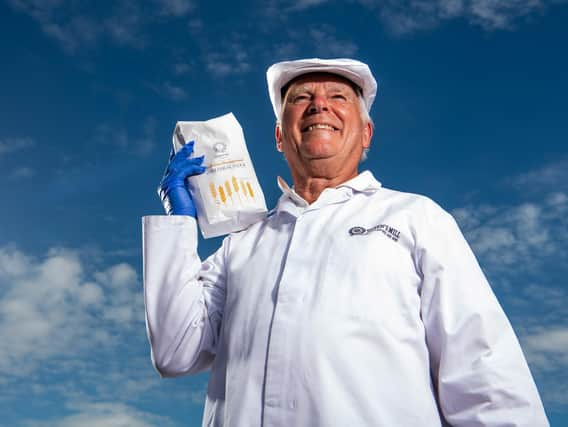The volunteer run heritage mill which has kept Yorkshire in flour


With a scarcity of it in the supermarkets, particularly during the beginning of the pandemic, volunteer-run Queen’s Mill which sits on the banks of the River Aire, in Castleford, found itself and its flour in big demand.
The heritage mill, which is also known locally as Allinson Mill, was in its heyday thought to be the largest stone grinding mill in the world.
Advertisement
Hide AdAdvertisement
Hide AdAlthough now on a much smaller scale, it still produces the stoneground wholewheat flour advocated by Victorian food pioneer and founder of famous flour company, Dr Thomas Allinson.
Head miller, David Weatherson, who is also a volunteer, is in charge of production and uses locally sourced wheat for the bags of Castleford Stoneground Wholewheat Flour which is stocked by independents including Bert’s Barrow and Farmer Copleys. It is also sold from outside the mill itself.
Fellow volunteer John Parker makes the deliveries.
“We are not a commercial mill and produce around half a tonne of flour a year,” Mr Parker explained.
“The wheat is local so our carbon footprint is low and it comes to us cleaned and conditioned ready to mill.”
Advertisement
Hide AdAdvertisement
Hide AdBut Mr Parker said demand for their flour rocketed when the lockdown first came in and they were a little concerned they may run out of wheat.
“We had a call from Charlotte at Bert’s Barrow asking for 100 bags of flour and the first thing we needed to do was get in some more wheat.
“Dave had the delivery ready two days later.”
So far during the lockdown period they have made £3,000 worth of sales which will help support the work of the mill’s owners, Castleford Heritage Trust.
The trust was formed in 2000, co-founded and chaired by the late Alison Drake, who Mr Parker said, was a passionate champion of the town.
Advertisement
Hide AdAdvertisement
Hide AdIn 2013, with the help of an anonymous benefactor, it bought the building which had closed its doors as a commercial enterprise around three years earlier and was heading to dereliction.
The building became the new base for the trust and provided space for offices, a live music venue, cafe and, of course, the mill itself.
Having stopped production in around 2010 when Canadian milling company ADM gave up the lease, work got underway in 2015 to adapt the stones and milling system to suit a smaller scale process.
“It was important to keep the mill’s heritage alive,” Mr Parker said.
Advertisement
Hide AdAdvertisement
Hide AdThere has been a long history of milling in Castleford, the mill was originally called Castleford Mill, which Mr Parker said is first recorded in 1093 by Robert de Lacey, Lord of Pontefract.
Historically, Mr Parker said, all mills were owned by the Crown and managed by the Lords of the Manor.
However, according to the West Yorkshire Archaeological Society, there is the possibility a working mill has been by the river Aire as far back as Roman times.
But the most significant change of ownership in Queen’s Mill’s history was in the 1700s.
Advertisement
Hide AdAdvertisement
Hide Ad“The mill was bought by the waterways,” Mr Parker explained.
“Firstly, the Aire & Calder Navigation Company then its successors, the British Waterways Board and Canal & River Trust.”
It remained under their ownership until it was bought by the trust.
Under the waterway’s ownership the mill was leased out to a number of companies including the one whose name stuck locally – Allinson. It was under Allinson’s tenure, which started in 1921, that stone milling was reintroduced to Queen’s Mill.
Advertisement
Hide AdAdvertisement
Hide AdThe previous leaseholder Harry Tennant & Co had big plans for the mill and installed steel rollers powered by steam to crush the grain. He also took out the two water wheels and replaced them with one which he connected to a dynamo.
The mill became the first building in Castleford to have electricity. Allinson wanted to return the mill to stonegrinding as the benefits of wholemeal flour in bread was the founding principle of the company.
Manchester-born Dr Thomas Allinson was a Victorian food pioneer who championed the benefits of wholemeal flour in bread.
Since the Industrial Revolution, nearly all flour had been produced using roller mills which meant the flour was heavily refined and lost a great deal of its nutrients and fibre.
Advertisement
Hide AdAdvertisement
Hide AdDr Allinson’s views on healthy flour were considered so radical he was struck off the medical register. So he made bread.
When, after the First World War, his ideas were borne out, he was offered reinstatement on to the register, he turned it down.
Allinsons produced flour in Queen’s Mill until the 1970s and the addition of various stones through the years, led to it being known as the biggest stone grinding mill in the world.
While the mill is currently closed to visitors, its part as a community hub is still vitally important.
Advertisement
Hide AdAdvertisement
Hide AdAs well as producing flour, it hosts the Castleford Support Hub which has a network of volunteers to help vulnerable people in the community.
“There is something special about the mill,” Mr Parker said.
“It is a lovely place to be.”